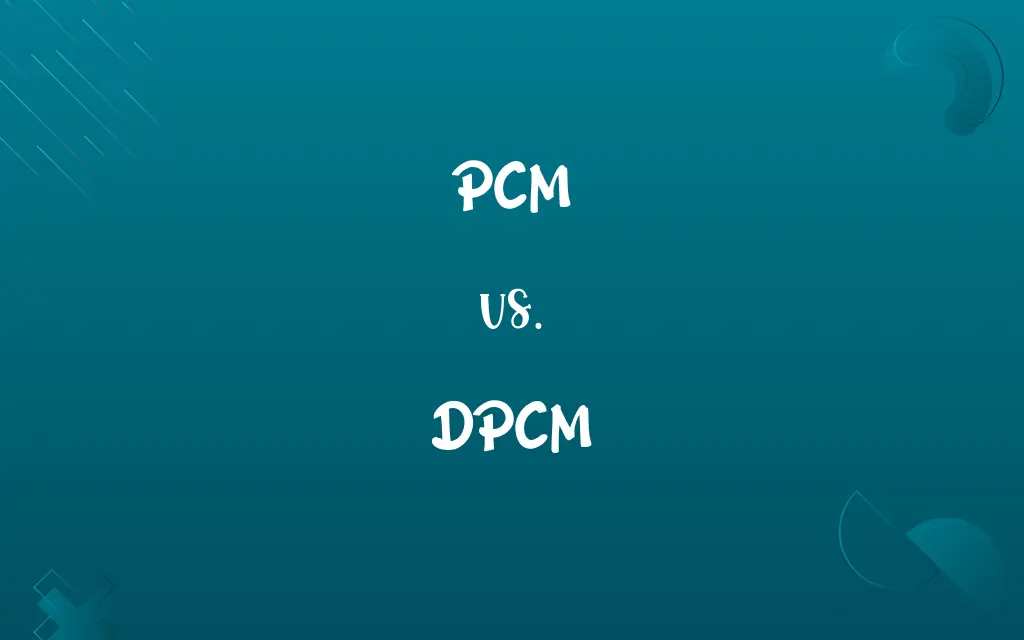PCM vs. DPCM: Know the Difference

By Shumaila Saeed || Published on February 4, 2024
PCM (Pulse Code Modulation) converts analog signals into digital by sampling, while DPCM (Differential Pulse Code Modulation) encodes the difference between consecutive samples.

Key Differences
PCM, or Pulse Code Modulation, is a method used to digitally represent analog signals. In PCM, the amplitude of the analog signal is sampled at regular intervals and then quantized to the nearest value within a range. DPCM, or Differential Pulse Code Modulation, is a variation of PCM that encodes the difference between consecutive samples rather than the absolute value of each sample.
Shumaila Saeed
Feb 04, 2024
In PCM, each sample is independent and represents the amplitude of the analog signal at a point in time. This method results in a high-quality digital representation of the original analog signal. In DPCM, each sample represents the difference from the previous sample, which can efficiently reduce the bit rate required for transmission.
Shumaila Saeed
Feb 04, 2024
PCM is widely used in audio CD formats, where high fidelity is essential. It produces a larger file size but with better sound quality. DPCM, on the other hand, is more commonly used in applications where bandwidth is limited, such as in video conferencing and mobile communication, because it can compress audio data more effectively.
Shumaila Saeed
Feb 04, 2024
The implementation of PCM is relatively straightforward but requires more storage space and bandwidth. DPCM, while more complex in its implementation, optimizes data usage and is more efficient for transmitting over limited bandwidth.
Shumaila Saeed
Feb 04, 2024
Both PCM and DPCM are crucial in the realm of digital audio and video processing. PCM stands out for its simplicity and high-quality output, whereas DPCM is notable for its efficiency in data handling and transmission.
Shumaila Saeed
Feb 04, 2024
ADVERTISEMENT
Comparison Chart
Encoding Method
Samples absolute amplitude values
Samples differences between consecutive values
Shumaila Saeed
Feb 04, 2024
Usage
High-fidelity audio, e.g., audio CDs
Bandwidth-limited applications, e.g., video conferencing
Shumaila Saeed
Feb 04, 2024
Data Size and Quality
Larger file size, higher quality
Smaller file size, lower quality
Shumaila Saeed
Feb 04, 2024
Bandwidth and Storage
Requires more bandwidth and storage
More efficient in bandwidth and storage usage
Shumaila Saeed
Feb 04, 2024
ADVERTISEMENT
PCM and DPCM Definitions
PCM
PCM ensures each audio sample is a direct representation of the original signal.
PCM's direct sampling technique captures the true essence of the sound wave.
Shumaila Saeed
Jan 25, 2024
DPCM
DPCM typically results in smaller file sizes compared to PCM.
DPCM files are smaller, making them suitable for streaming services.
Shumaila Saeed
Jan 25, 2024
PCM
PCM is a method of converting analog audio signals into digital form by sampling the amplitude at regular intervals.
Audio CDs use PCM to deliver high-quality sound.
Shumaila Saeed
Jan 25, 2024
DPCM
DPCM is useful in applications where bandwidth is limited.
In video conferencing, DPCM helps in managing bandwidth effectively.
Shumaila Saeed
Jan 25, 2024
PCM
PCM is widely used in professional audio recording due to its high fidelity.
Studio recordings often rely on PCM for preserving the clarity of sound.
Shumaila Saeed
Jan 25, 2024
ADVERTISEMENT
DPCM
DPCM encodes the difference between successive samples to efficiently compress audio data.
DPCM reduces data transmission costs by encoding only the differences in sound.
Shumaila Saeed
Jan 25, 2024
PCM
PCM data is typically uncompressed, resulting in larger file sizes.
PCM files are larger than MP3s due to their uncompressed format.
Shumaila Saeed
Jan 25, 2024
DPCM
DPCM is often used in mobile communications to optimize data usage.
Mobile networks frequently utilize DPCM for audio data compression.
Shumaila Saeed
Jan 25, 2024
PCM
PCM is fundamental in digital audio technologies and telecommunications.
PCM technology is a cornerstone in digital telephony systems.
Shumaila Saeed
Jan 25, 2024
DPCM
DPCM can sometimes lead to lower sound quality due to its differential nature.
While efficient, DPCM may not capture all nuances of complex audio.
Shumaila Saeed
Jan 25, 2024
Repeatedly Asked Queries
What is PCM?
PCM (Pulse Code Modulation) is a digital representation of an analog signal where the magnitude of the signal is sampled regularly at uniform intervals.
Shumaila Saeed
Feb 04, 2024
How does PCM work?
PCM works by sampling the amplitude of an analog signal at regular intervals and converting these samples into digital form.
Shumaila Saeed
Feb 04, 2024
What is DPCM?
DPCM (Differential Pulse Code Modulation) is a compression technique that encodes the difference between successive samples.
Shumaila Saeed
Feb 04, 2024
Is DPCM more efficient than PCM?
Yes, DPCM is more efficient in terms of data usage and bandwidth requirement compared to PCM.
Shumaila Saeed
Feb 04, 2024
Where is DPCM typically used?
DPCM is typically used in bandwidth-limited applications like video conferencing and mobile communication.
Shumaila Saeed
Feb 04, 2024
Can PCM handle complex audio signals effectively?
Yes, PCM can handle complex audio signals effectively due to its high fidelity sampling.
Shumaila Saeed
Feb 04, 2024
In what applications is PCM commonly used?
PCM is commonly used in high-fidelity audio applications like audio CDs and professional audio recording.
Shumaila Saeed
Feb 04, 2024
What are the advantages of DPCM?
The advantages of DPCM include reduced file size and efficient bandwidth usage.
Shumaila Saeed
Feb 04, 2024
How does DPCM differ from PCM?
DPCM encodes the difference between consecutive samples, rather than the absolute value of each sample as in PCM.
Shumaila Saeed
Feb 04, 2024
Are PCM files typically larger than DPCM files?
Yes, PCM files are typically larger than DPCM files due to lack of compression.
Shumaila Saeed
Feb 04, 2024
Does PCM have better quality than DPCM?
Yes, PCM generally has better quality than DPCM as it directly samples the original signal.
Shumaila Saeed
Feb 04, 2024
Is DPCM suitable for high-quality audio recording?
DPCM is less suitable for high-quality audio recording due to potential quality loss from differential encoding.
Shumaila Saeed
Feb 04, 2024
What are the drawbacks of PCM?
The main drawback of PCM is its larger file size and higher bandwidth requirement.
Shumaila Saeed
Feb 04, 2024
Is DPCM good for streaming applications?
Yes, DPCM is good for streaming applications due to its efficient data handling.
Shumaila Saeed
Feb 04, 2024
How does PCM impact the storage of audio files?
PCM increases the storage requirements for audio files due to its uncompressed nature.
Shumaila Saeed
Feb 04, 2024
Can DPCM be used for high-definition audio?
DPCM is not ideal for high-definition audio due to potential quality loss.
Shumaila Saeed
Feb 04, 2024
Is PCM more complex to implement than DPCM?
PCM is simpler in its basic form compared to DPCM, which requires differential encoding.
Shumaila Saeed
Feb 04, 2024
Does DPCM reduce transmission costs?
Yes, DPCM can reduce transmission costs by reducing the amount of data needed to be transmitted.
Shumaila Saeed
Feb 04, 2024
Is PCM used in video processing?
PCM is not typically used in video processing; it's primarily used for audio.
Shumaila Saeed
Feb 04, 2024
Does DPCM affect audio quality?
Yes, DPCM can affect audio quality due to its compression technique.
Shumaila Saeed
Feb 04, 2024
Share this page
Link for your blog / website
HTML
Link to share via messenger
About Author
Written by
Shumaila SaeedShumaila Saeed, an expert content creator with 6 years of experience, specializes in distilling complex topics into easily digestible comparisons, shining a light on the nuances that both inform and educate readers with clarity and accuracy.








































































